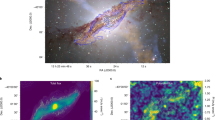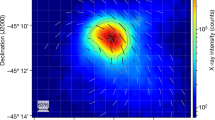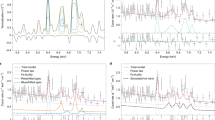Abstract
In 1963 it was reported1 that an enormous explosion (∼1055 erg) had occurred about one million years ago in the nuclear region of the nearby irregular galaxy M82. Deep photographic plates showed a spectacular filamentary system extending to 200 arc s (∼3 kpc) along the minor axis of the galaxy and Hα spectroscopy revealed a steep velocity gradient in this direction, suggesting expulsion of the ionized gas from the core of the galaxy1,2. Thereafter, broadband polarimetry showed the filaments to be linearly polarized (15–30%) at optical wavelengths, with electric vectors generally perpendicular to the radius vector from the centre3,4, indicating that the light has been scattered by particles into our line of sight5. The explosion hypothesis6 was questionable in that the observed blueshifts and redshifts cannot arise from explusion or infall, as the particles would scatter only redshifted or blueshifted light respectively on both sides of the galaxy. Although the nature of M82 remains a mystery, two significant observations have been largely overlooked. From imaging polarimetry, Schmidt et al7. demonstrated that most of the visual polarized flux arises from a smooth component which is symmetric over the main body of the galaxy. Axon and Taylor found well organized Hα line-splitting over ∼60 arc s at two long-slit positions south of the galaxy and parallel to the major axis8. Here we present new imaging Fabry–Perot observations of M82 for the Hα and [N II] λ6,583 spectral lines9. Our observations show for the first time that the line and continuum emission above and below the galactic disk arise from two morphologically and kinematically distinct components. The first component consists of filamentary, narrow-line emission (full width at half maximum, FWHM <200 km s−1) organized into a bipolar outflow over the surfaces of two elongated bubbles. We present direct evidence for a second component of broad-line (at FWHM 300 km s−1) and continuum emission arising from a faint exponential halo that rotates slowly with the disk.
This is a preview of subscription content, access via your institution
Access options
Subscribe to this journal
Receive 51 print issues and online access
$199.00 per year
only $3.90 per issue
Buy this article
- Purchase on Springer Link
- Instant access to full article PDF
Prices may be subject to local taxes which are calculated during checkout
Similar content being viewed by others
References
Lynds, C. R. & Sandage, A. R. Astrophys. J. 137, 1005–1021 (1963).
Burbidge, E. M., Burbidge, G. R. & Rubin, V. C. Astrophys. J. 140, 942–968 (1964).
Elvius, A. Lowell Obs. Bull. 5, 281–294 (1963).
Sandage, A. R. & Miller, W. C. Science 144, 405–409 (1964).
Solinger, A. B. Astrophys. J. 155, 403–415 (1969).
Sanders, R. H. & Balamore, D. S. Astrophys. J. 166, 7–12 (1971).
Schmidt, G. D., Angel, J. R. P. & Cromwell, R. H. Astrophys. J. 206, 888–897 (1976).
Axon, D. J. & Taylor, K. Nature 274, 37–38 (1978).
Bland, J. & Tully, R. B. Bull. Am. astr. Soc. 19, 637 (1986).
Osterbrock, D. E. Astrophysics of Gaseous Nebulae 156 and 163 (Freeman, New York, 1974).
Wyckoff, S., Wehinger, P. A., Fosbury, R. A. E. & McMullan, D. Astrophys. J. 206, 254–256 (1976).
Watson, M. G., Stanger, V. & Griffiths, R. E. Astrophys. J. 286, 144–158 (1984).
Kronberg, P. P., Biermann, P. & Schwab, F. R. Astrophys. J. 291, 693–707 (1985).
Lo, K. Y. et al. Astrophys. J. 312, 574–591 (1987).
Nakai, N. et al. Proc. astr. Soc. Japan (in the press).
Bingham, R. G. et al. Nature 259, 463–465 (1976).
Sandage, A. & Visvanathan, N. Astrophys. J. 157, 1065–1074 (1969).
Visvanathan, N. & Sandage, A. Astrophys. J. 176, 57–74 (1972).
Visvanathan, N. Astrophys. J. 192, 319–324 (1974).
Rieke, G. H., Lebofsky, M. J., Thompson, R. I., Low, F. J. & Tokunaga, A. T. Astrophys. J. 238, 24–40 (1980).
Telesco, C. M. & Harper, D. A. Astrophys. J. 235, 392–404 (1980).
Kronberg, P. P. & Sramek, R. A. Science 227, 28–31 (1985).
Chevalier, R. A. & Clegg, A. W. Nature 317, 44–45 (1985).
O'Connell, R. W. & Mangano, J. J. Astrophys. J. 221, 62–79 (1978).
McCarthy, P. J., Heckman, T. & van Bruegel, W. Astr. J. 92, 264–275 (1987).
Author information
Authors and Affiliations
Rights and permissions
About this article
Cite this article
Bland, J., Tully, R. Large-scale bipolar wind in M82. Nature 334, 43–45 (1988). https://doi.org/10.1038/334043a0
Received:
Accepted:
Issue Date:
DOI: https://doi.org/10.1038/334043a0
This article is cited by
-
Bipolar outflows out to 10 kpc for massive galaxies at redshift z ≈ 1
Nature (2023)
-
Galactic winds: a short review
Astrophysics and Space Science (2007)
-
Narrow-line dynamics in Seyfert and starburst nuclei
Astrophysics and Space Science (1990)
Comments
By submitting a comment you agree to abide by our Terms and Community Guidelines. If you find something abusive or that does not comply with our terms or guidelines please flag it as inappropriate.



